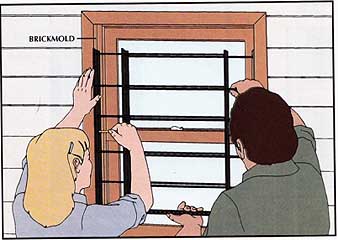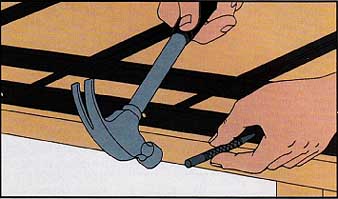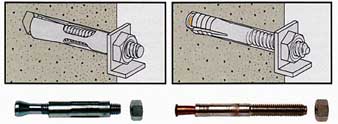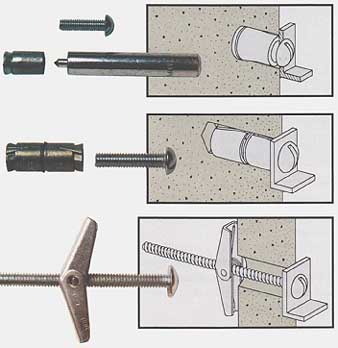A ready-made, adjustable steel grille is au easy-to-install barrier for a window. For maximum protection, it should be mounted inside, but because this prevents easy operation of the window sash, the usual position is outside. Grilles of this type are fastened to the sides of the window frame.
Attaching a Grille to Wood: In many modern frame homes the out side window recess is so shallow that the only attachment available is the brickmold. Generally this exterior wood trim is only inch thick, in sufficient for long screws; as a result, the grille may not foil a determined burglar, although it can deter an intruder. In older homes, where the window is recessed more than 2 inches from the outer face of the wall, grilles can be screwed through the jamb into a stud.
Attaching to Masonry: Tithe window frame is masonry, use expansion anchors. The holding power of the anchors depends on the composition of the wall—concrete is strongest, brick weakest—and on the tightness of pilot holes. In old, powdery masonry, the bit size recommended by the anchor manufacturer may make too large a hole; experiment with smaller bits.
With brick walls, locate the anchors in horizontal mortar joints, not the weaker vertical joints or the middle of a brick. The outside diameter of the anchor should match the thickness of the joints (usually inch).
A Final Precaution: To prevent a burglar from removing the grille fasteners, use screws with one- way heads. Ii you can't obtain them or must make do with larger fasteners—lag screws, machine bolts, or machine nuts—erase the screw slot or round the bolt or nut with a grinder.
TOOLS:
- Hammer drill with carbide bit (solid concrete wall)
- Electric drill with masonry bit (brick wall)
- Electric drill with twist bits (high-speed steel for metal, carbon steel for wood)
- Hammer
- Center punch
MATERIALS:
- Window grille
- Masonry anchors
- Wood screws (1¼” No. 12)
- Lag screws (¼” x 2½” and washers)

Mounting on adjustable grille in wood.
Fasten a grille to the brick-mold only if there is no other choice.
• Telescope the grille against the brick-mold, center it vertically, and have a helper mark the inner edges of the brick-mold through the holes in the mounting strips.
• Drill pilot holes at the marks and fasten the grille with 1¼-inch-long No. 12 wood screws.
If you can fasten the grille through the window jamb into the studs, place it against the strip of wood (called a blind stop) next to the window sash, and attach it with 2½-inch long ¼-inch lag screws and washers.

Mounting an adjustable grille in masonry.
• Center the grille in the opening and mark each mounting strip at intervals of about 8 inches, setting the marks at horizontal mortar joints in a brick wall or at the centers of blocks in a masonry-block wall.
• Remove the grille and strike the strip with a center punch opposite each mark.
• Choose anchors appropriate to the wall (below) and drill holes in the strip for the fasteners.
• Replace the grille, mark each hole’s location on the masonry, and drill holes for the anchors.
• Insert the anchors and fasten the grille to them. Stop tightening each fastener as soon as you feel substantial resistance.
Anchors for Masonry Walls

Threaded stud anchors.
Designed for use with a machine nut and a washer, these anchors get their strength from especially deep pilot holes. The anchor at far left tightens against the masonry when the nut forces a split sleeve over the bolt’s mushroom-shaped end. The anchor at near left is tightened against the masonry by a few hammer blows that force the tapered pin into the split section of the shank; once tightened, the anchor can't be removed.

A hammer-set anchor. Especially suitable for shallow holes, this anchor is set with a hammer and a special tool provided by the manufacturer. As the tool drives the lead sleeve down over the plug, the bottom of the plug forces the sleeve out against the masonry.
A drop-in anchor. This anchor, suited to old or weak brick walls, is simply inserted into a snug pilot hole. As a machine screw or machine bolt is tightened, wedges at the ends of the anchor force the two sleeves apart, creating an even pressure along the entire length of the hole.
An anchor for concrete blocks. This toggle bolt provides excellent holding power in weak materials such as crumbly cinder block. The toggle unfolds in the space inside a block and is pulled back against the wall of the block as the bolt is tightened.
Previous: Panes of Shatter-Resistant PlasticNext: Safes and Vaults for the House